Last year, Aleksandar Pejic discussed DNEG‘s involvement in Fast X. Today, he shares his experiences stepping into the MonsterVerse for the first time with Godzilla x Kong: The New Empire.
Lee F. Sullivan brings almost 30 years of visual effects expertise to the table. From his beginnings in various studios to his current role at DNEG since 2016, his portfolio shines with films such as Life, Pacific Rim: Uprising, Glass Onion, and Aquaman and the Lost Kingdom.
Earlier this year, Spencer Cook delved into his creative process behind No One Will Save You. Now, he’s resurfacing within the MonsterVerse.
What is your background?
Aleks: I have a degree in architecture then went onto doing a master in computer imaging and MBA.
Lee: I studied International Relations at university but got an internship in VFX just after graduating and it somehow morphed into a career.
Spencer: I started my animation career as a stop motion animator. I’ve been a fan of monster movies since childhood. I loved all the early Godzilla movies but I was especially inspired by the works of Ray Harryhausen at a young age. I experimented with stop motion animation with my Dad’s super-8 movie camera starting around 11 years old. It was a hobby that turned into a career. I moved to New York City and spent years as a professional stop motion animator animating characters for TV commercials and TV shows like Pee Wee’s Playhouse. Once the industry began to transition away from traditional forms of animation and into digital tools I moved to Los Angeles and learned how to animate on a computer. That’s where I started working on Hollywood movies and now here we are today in Montreal continuing to work on cool monster movies like the ones that inspired me as a kid.
What was your feeling about entering the MonsterVerse?
Aleks: Entering the MonsterVerse was both a privilege and exciting. Both Godzilla and Kong go all the way back to the early years of filmmaking and stand as timeless icons. They belong in a revered circle of cinematic royalty. Being part of the creative process behind a film that unites these legendary creatures was not only a thrilling experience but also nail-biting. The enormity of Godzilla and Kong’s presence in the MonsterVerse was evident in every aspect of production. Their sheer size dictated the scale of every element, leaving no room for compromise or shortcuts. It was a constant reminder that in this colossal world of monsters, size really does matter, and every aspect of their portrayal had to be larger than life. For someone who remembers and was a big fan of the first King Kong movie from 1933 as a child, the experience of contributing to the MonsterVerse was about honouring the legacy of these iconic characters and delivering an unparalleled cinematic spectacle that resonated with fans across generations.
Spencer: It’s great to be a part of the latest incarnations of these classic monsters. This is my second MonsterVerse movie after having supervised the animation for Godzilla: King of the Monsters. My 12 year old inner child was very happy about this.
Lee: It’s a big challenge to take on such iconic characters as Godzilla and King Kong; they are a cinematic treasure that you’re privileged to carry for a while, and it’s no small responsibility to bring them to life on the big screen. One interesting aspect of working on these films is that while Godzilla and Kong do of course spend some screen time smashing things up, there is a lot of emotive screen time where you’re looking at their subtle performance which presents its own unique challenges because in those shots you can’t hide behind motion blur or dust clouds. Of course you spend all this time staring at the monsters, but it’s easy to underestimate the huge amount of environment work to create the world for them to live in (and to smash up!).
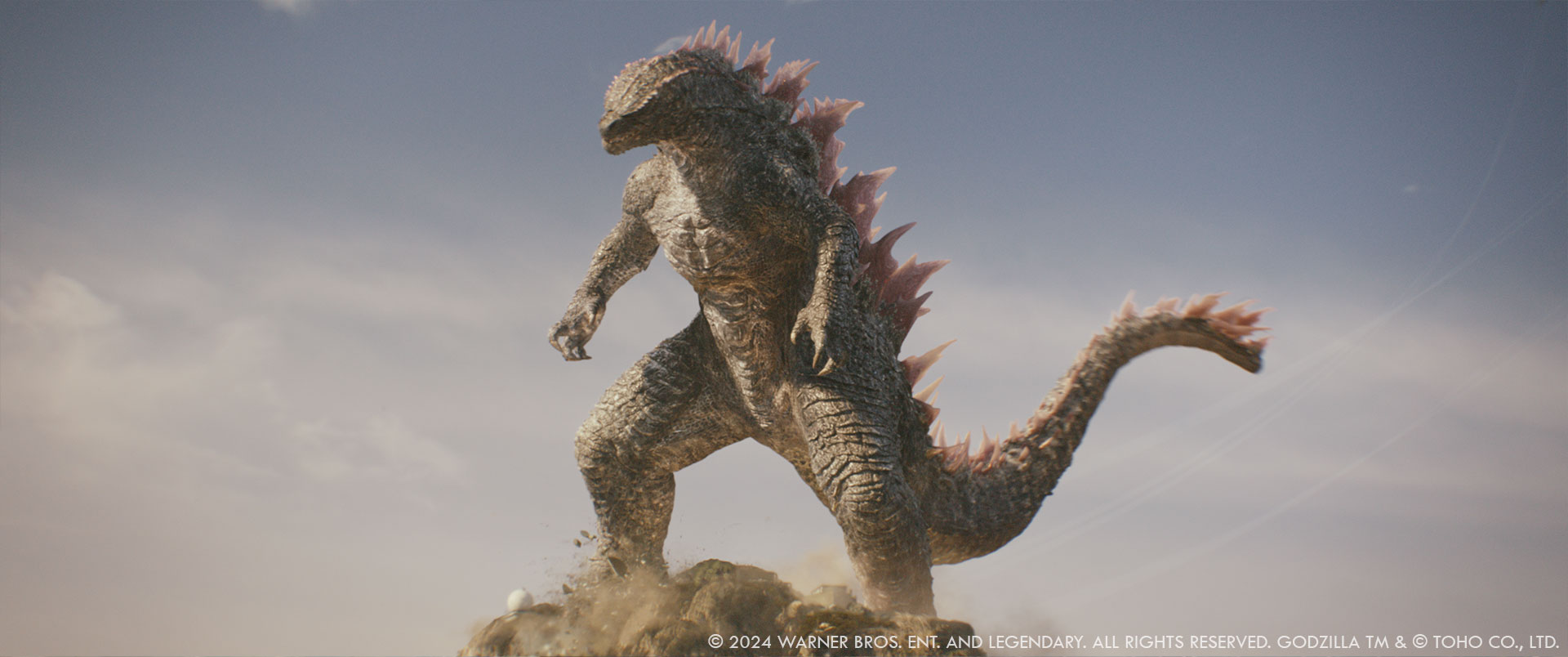
How was the collaboration with director Adam Wingard and VFX Supervisor Alessandro Ongaro?
Aleks: Collaborating with overall production VFX Supervisor Alessandro Ongaro was an enriching and dynamic experience. Throughout the production process, you always find that certain creative aspects may need more refinement or changes based on evolving needs. This flexibility allowed us to adapt and refine our work, making sure that every detail contributed seamlessly to Adam and Alessandro’s overall vision. Working alongside other facilities necessitated a collaborative approach from the very beginning where Alessandro played a pivotal role, constantly sharing feedback, insights and updates to ensure smooth workflows across VFX partners. Our weekly reviews served as a vital communication channel, bridging the geographical gaps as we coordinated efforts across different parts of the world.
How did you organize the work between you and your VFX Producer?
Aleks: Organising work with our VFX Producer, Krzysztof Szulc and Executive Producer Laura Schultz, was all about teamwork and knowing the ins and outs right from the start. They were hands-on from day one, diving deep into every detail of what’s required for this type of the project. Our approach was simple: assign tasks to the best-suited artists for the job. Dealing with time zones had its challenges, but having key senior talent in different locations who really understood what was needed made a huge difference. They were all deeply involved with available video recordings of our review sessions with Alessandro and could take a brief and run with it, delivering great results with minimal back-and-forth. This setup kept things smooth and efficient throughout the project.
Lee: Krysztof and Laura are very hands-on dedicated people, and we were in constant communication about how to adjust our approach to various aspects of the show as we went along. It helps enormously to have colleagues you can communicate honestly with and trust each other as a project spreads around the globe, with so many moving parts, going through various phases of ramping up and course correction.
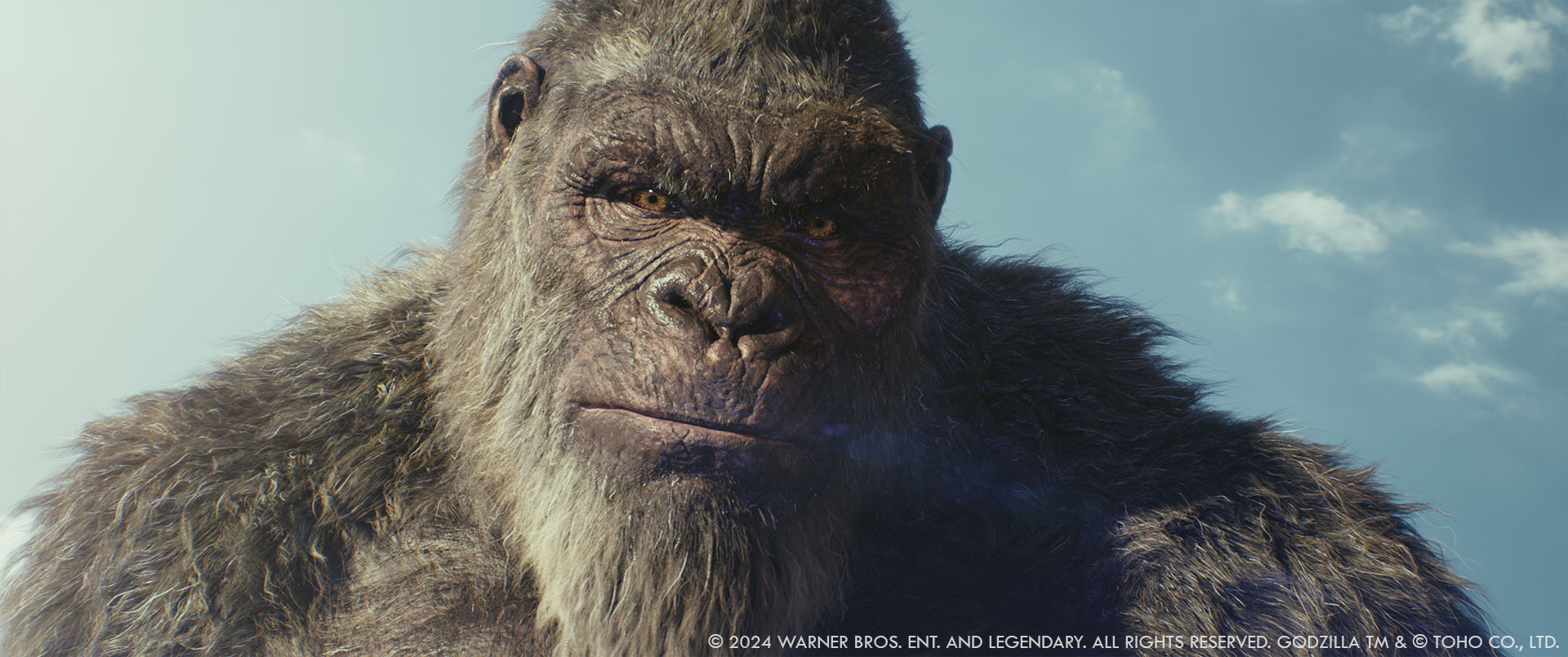
What are the sequences done by DNEG?
Aleks: DNEG led the Rome fight between Godzilla and Charybdis, Monarch Island, Entering Hollow Earth and discovering the Pyramid and the Iwi village, as well as the Engineering room.
Spencer: DNEG also worked on the scenes where Kong emerges from the vortex at the Monarch base, his tooth extraction, “Godzilla Evolved” emerging out of the ice and jumping off the rock of Gibraltar.
What were the initial creative inspirations behind the designs for King Kong, Godzilla, and Charybdis?
Aleks: The initial creative inspirations behind the designs for King Kong and Godzilla were rooted in a desire to maintain the iconic looks from previous films while incorporating latest shading, and enhanced textures. In the case of Charybdis, we had more scope to creatively contribute to the client’s design. DNEG took the lead in experimenting with different looks, colour palettes, and textures. After thorough review and input from Alessandro and Adam, a particular version stood out and was approved for the movie. This collaborative process ensured that each creature’s design not only honoured their cinematic legacy but also contributed to the visual richness of the MonsterVerse universe.
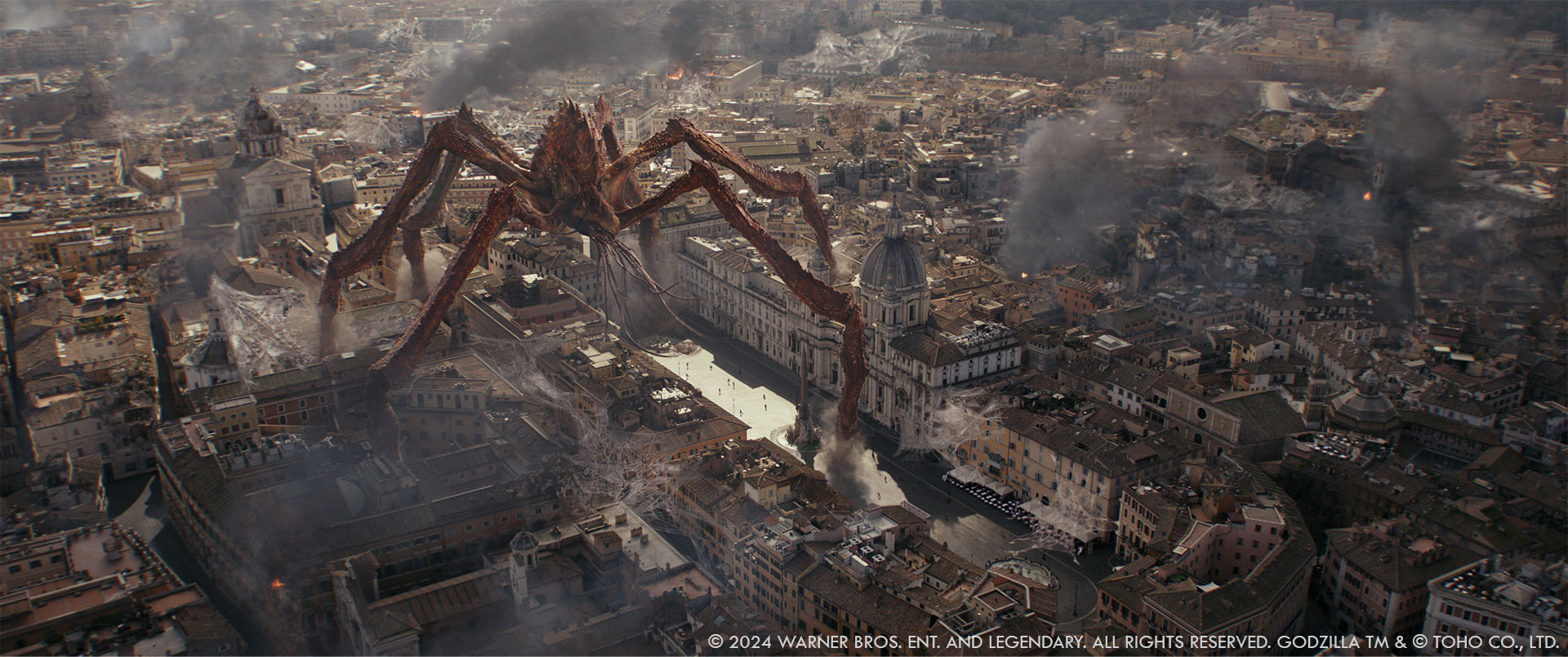
Can you discuss the collaborative process between concept artists, animators, and the director in bringing these creatures to life on screen?
Aleks: The collaborative process between Alessandro and our concept artists, animators, and the director was integral to bringing the creatures to life on screen. The DNEG art department, led by Global Head of Art Ravi Bansal and Art Director Marc Simonetti, played a crucial role in various aspects of our work. They were heavily involved in crafting the Pyramid look, the Hollow Earth, the Engineering Room, and specific visuals tailored for shots. Engaging the art department proved to be not only time-effective in generating visuals for client discussions but also invaluable in aiding shot production and helping artists grasp the shoot components more efficiently. When it came to bringing the creatures to life, the animation team, spearheaded by Spencer Cook, took charge. They navigated through the animation steps, ensuring that our beloved monsters were brought to life in a manner that resonated with both the creative vision and technical requirements of the project. This collaborative effort ensured that each creature’s presence on screen was not just visually striking but also seamlessly integrated into the narrative fabric of the film.
What were some of the key challenges faced in animating King Kong, Godzilla, and Charybdis, considering their differing sizes, movements, and visual styles?
Aleks: Animating King Kong, Godzilla, and Charybdis posed several key challenges due to their differing sizes, movements, and visual styles. Both Kong and Godzilla boast a well-established catalogue of signature movements, each deeply ingrained in their respective cinematic histories. Our animation process needed to honour these iconic movements while also infusing them with new life and detail to meet modern standards and audience expectations.
Lee: For Godzilla we had the challenge of implementing two versions of the character; the traditional design from previous films, and the new “Godzilla Evolved” character, which has different proportions and overall less flesh on the body and legs, which meant we had to develop new levels of muscle and skin interaction for the new body type. The new Godzilla design has pink dorsal spines instead of the previous blue tint. We were rolling this new look out when the Barbenheimer hype was at its peak, so we nicknamed the new variant “Barbiezilla”. A key challenge for Kong is that we all relate to a simian face and body type as a human character rather than a monster, so it requires a lot of subtle work especially around the face to create a compelling performance. We also had particular challenges of very high levels of detail in Kong’s skin, fur, and flesh simulation in the tooth extraction sequence where we are so close to the face. Charybdis is a bit easier because it’s such an alien form, although there was some back and forth on how flexible its carapace and softer body parts should be. The other key conceptual point for Charybdis was developing its goo spray effect; is it slime or webbing? Does it glob onto a surface or drip? How much area does it cover? Does it destroy structures on impact or span gaps and stick like a spider’s web? For this kind of effect, even if you have an approved still frame concept, you have to start exploring the dynamic options in context at scale, and pitch an idea.
Spencer: Godzilla has a long cinematic history. The Toho “man in a suit” technique is beloved by generations of movie fans. However, one of the guiding principles of the MonsterVerse is to make the Titans seem like real animals. Integrating them into the real world and making it believable was always a top priority. We spent a lot of time gathering and studying animal videos of large powerful animals like grizzly bears, elephants, walruses, giraffes, etc. to guide the reality of body language. Kong’s body language was well established by Weta FX and Scanline VFX plus the previous MonsterVerse films by the time DNEG came onto the project. It was initially quite a challenge to make our Kong look like their Kong but once we got there he integrated well with all the other sequences. Kong is the only Titan that we used motion capture for. I directed a Mocap session with professional performer Ace Ruele in London based on the requirements of our sequences. We tended to layer in more keyframe animation to replace the Mocap over time as the sequences evolved and Kong’s performance changed but it did give us a good foundation in most cases. Godzilla and Charybdis were all keyframed. One of the key challenges in animating creatures of such gargantuan scale is preserving the weight and scale even during fast actions.
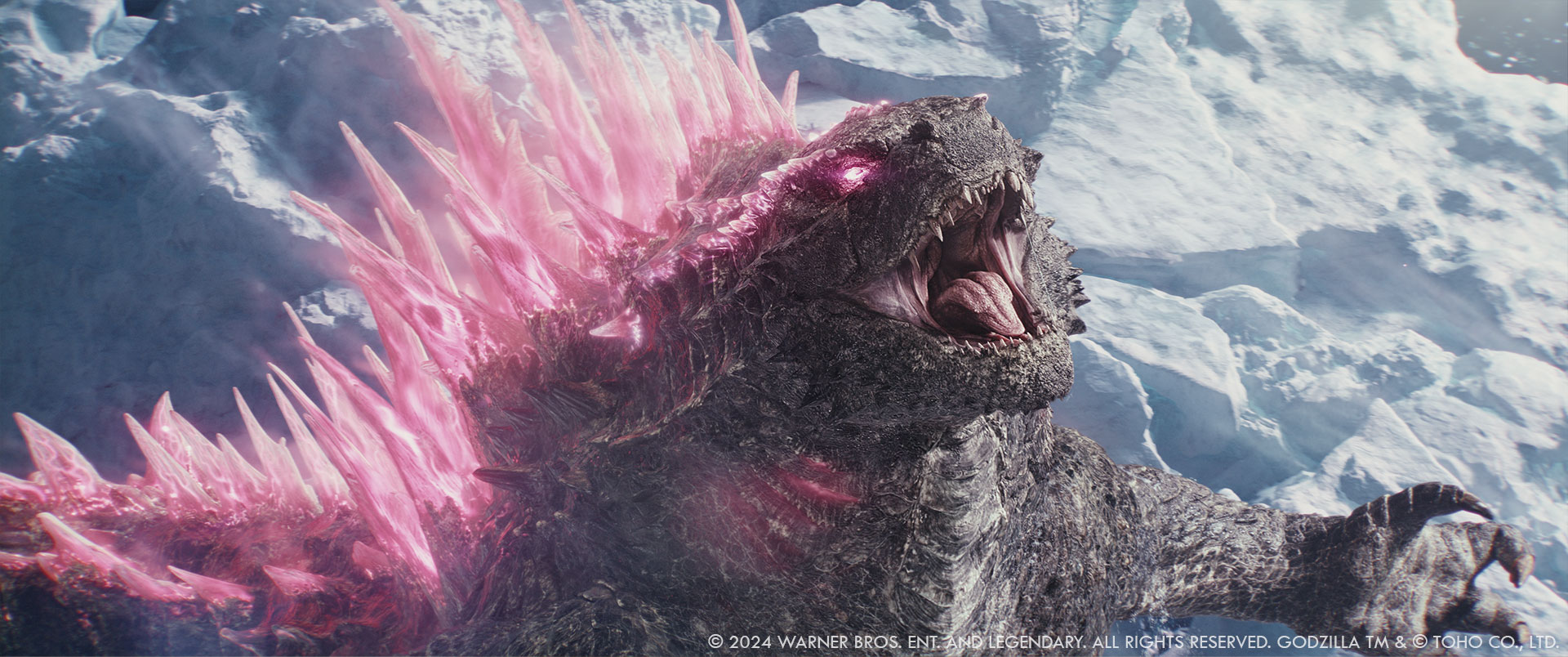
Were there any specific cultural or historical references that influenced the portrayal and behavior of these monsters in the film?
Spencer: Aside from large animal video references for body language, I felt it was important that my team of animators were familiar with the history of Godzilla and Kong. We didn’t want to match any of the “man in a suit” look for Godzilla or the stop motion posing for Kong but there are subtle touches of the classics in some of our poses.
How did advancements in CGI and motion capture technology impact the creation and animation of these iconic monsters compared to previous iterations?
Spencer: The most useful advancements for us in animation are things like improved rigs that allow us to work faster and focus more on creative choices and less on technical considerations. As far as Mocap goes, this was the first time I directed a session remotely. DNEG has a great Mocap stage in London with a big volume but I was in Montreal. The team in London set up cameras so I could see the performance from multiple angles. They also had a large monitor with my Zoom window on so Ace could easily see and hear me. It really worked well and we captured a ton of action that day that was very useful.
What were the considerations taken into account when choreographing the epic battle sequences between King Kong and Godzilla, as well as other confrontations involving Charybdis?
Spencer: The main battle sequence we did at DNEG was the fight in Rome between Godzilla and Charybdis. This fight kicks off the movie and reminds the audience just how formidable Godzilla is, Charybdis didn’t stand a chance! It was important to show Godzilla’s speed and agility. His run was established in Godzilla: King of the Monsters and since I supervised the animation on that movie I was well acquainted with how to portray that action. This time around, I wanted to make it more dynamic so we had Godzilla lean down and grab the ground and a surrounding building to help build up momentum as he begins to run. We designed Charybdis’ run from scratch. We did many tests based on spiders and crabs that were looking a little too skittery for such a massive creature. The breakthrough came when our Lead Animator Sebastian Weber found a slow motion video of a “galloping” spider. It was perfect for the scale and gave Charybdis a feeling of speed and power that didn’t look like a skittering spider.
Were there any particular scenes or moments in the film that posed significant animation or design challenges for your team?
Aleks: The Pyramid, Ceremonial Chamber, and Engineering Room scenes were quite challenging for us. They’re all part of the same asset and environment, but each has its unique visual flair. For instance, the Pyramid surface has this distinct Iwi caving on the outside where the Ceremonial Chamber inside the Pyramid has these elongated crystals on the walls. They both need to feel they belong to the same visual language. The shading was key to nailing the look, especially with reflections and refractions. And then there’s the Engineering Room, which had to match the world above but with its own twist and different colour pallet. It was all about finding the connecting visual elements.
Lee: One challenging asset we developed was the Veil that the main characters must pass through, deep in the Hollow Earth jungle. On set, the actors poked and prodded a backlit burlap sheet, eventually tearing through the cloth as a hot light shines on them through the gap. In the script it simply says ‘an organic barrier’ blocks their way and Alessandro was very clear from the start that this shouldn’t be a typical sci-fi energy shield. It had to feel like a curtain of translucent skin with pulsing veins. We explored several kinds of subcutaneous structures and finally focused on fibrous structures flowing in localised currents, which we nicknamed the ‘seaweed’ layer. As Dan Stevens then pokes the surface, the organic energy dissipating through the outer veins was inspired by time lapse photography of slime molds expanding across rotting logs. Then as the characters ripped the barrier open, we revealed layers of delicate subdermal structure pulling apart and fine tuned the lighting and comp to match the intense onset lighting.
The Pyramid was another technical and aesthetic challenge because it’s a translucent crystal material that you see from multiple distances; miles away and then climbing up the surface steps. Another complication was our CG Pyramid had to match the fluctuating interactive colored lighting on the actors and live action set, so we developed the pulsing internal energy dissipating through the layers of the crystalline structure. The structural implementation of the Pyramid as an asset was quite different depending on the viewing distance.
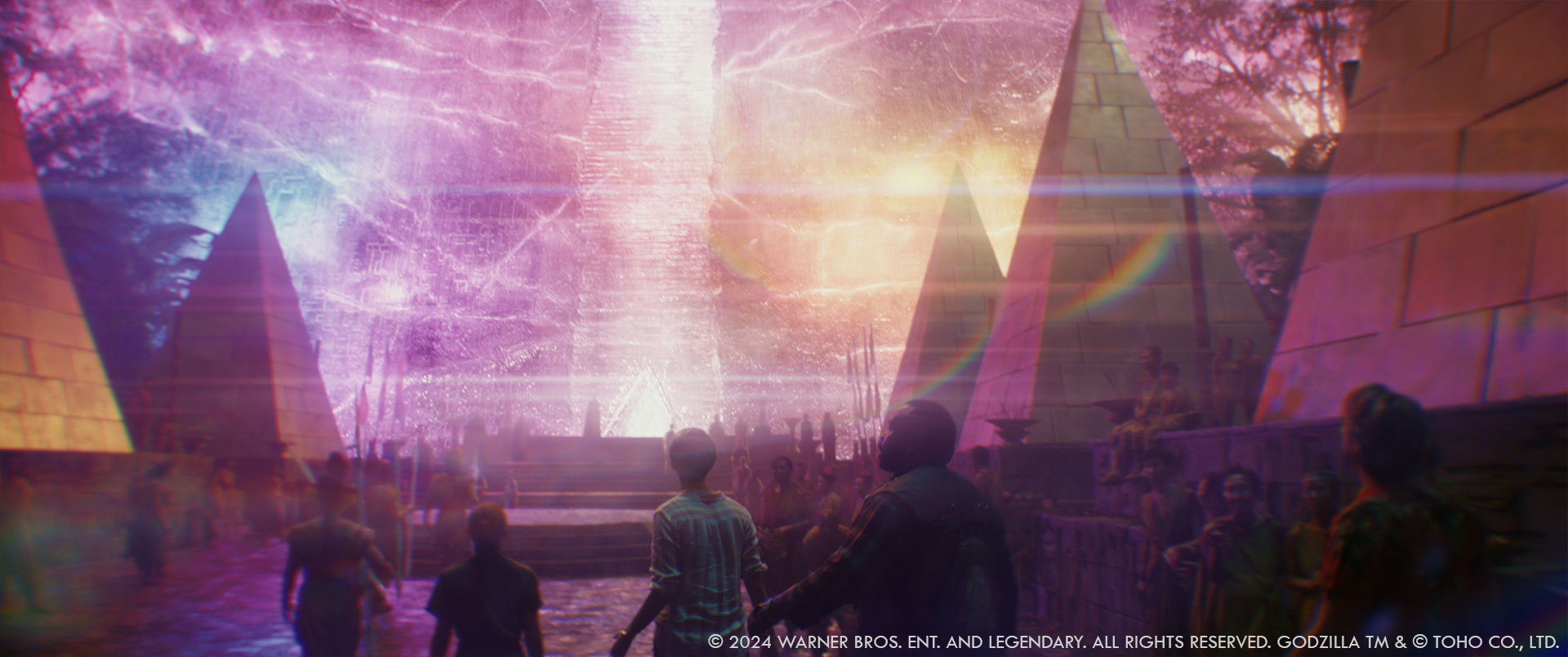
How did your team balance the need for realism with the fantastical elements inherent in a film featuring giant monsters battling it out in urban environments?
Lee: Two of the key challenges for giant monsters are to define their speed of movement in a given context, and then to resolve the speed and layering of detailed interactivity happening all around them. Speed is a challenge because you usually slow things down significantly to imply something is huge, but because you relate to these characters on a human level, and because a whole action scene in titan-scale slow-motion would feel odd, you’ll tend to play action shots, medium shots and closeups closer to human scale. That works well until you cut to a wide shot and they smash a building or splash water around, at which point you have to play out the secondary FX at a real-world scale and speed. So you’re not always working to a single scale, speed or amount of gravity, you usually have to figure out what works best for each shot.
Could you provide insights into the creative process behind designing environments such as the Crystal Pyramid and the Pacific Base?
Lee: The Monarch Base was probably the most straightforward environment because we know what a tropical island in the ocean looks like. However, there were some creative and storytelling notes to develop in terms of the layout of the airport, the village with the school, the shoreline and the portal to Hollow Earth. There were also some variations and rebuilds in terrain layout between the different sequences. We had to set up how the trees interacted with Kong when he was on the ground, and when the trees were pushing against Kong’s skin and fur.
The Pyramid as an asset was a major challenge in itself, but then we also designed and built this enormous cave subsection of Hollow Earth all around the Iwi village location. The established look of Hollow Earth is a parallel top and bottom sides of the world facing each other, which I called the “sandwich”. Around the Iwi Village, the world slopes up and around in a continuous sloping surface around the top to the bottom, which I nicknamed the “burrito”. It was an interesting challenge to add visual cues all around this sloping surface to give you a feeling of the variation of “which way is up,” all without breaking the enormous scale of the environment; and it was punctured by the swirling portals to the surface world which had to be visible for specific story beats.
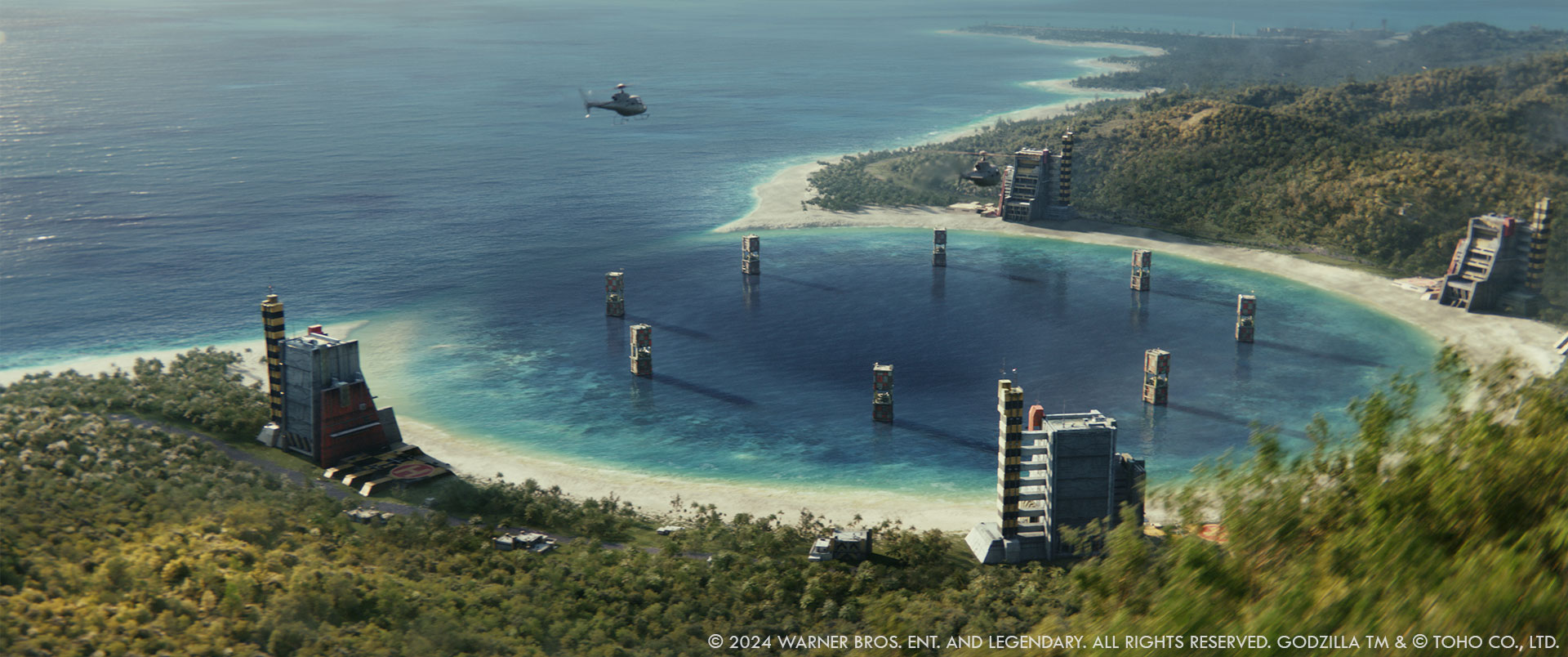
Which location was the most complicated to create?
Aleks: I found the Pyramid very challenging due to its enormous scale with nothing in the real world to compare it to. It also didn’t help that I spent years in lighting and my brain was flagging potential through the roof rendering times from the second I saw the first concept. Usually, we start from real life examples, we discuss, analyse and then go from there with all departments. We would go through their methodology and discuss the approach but in this particular case, we had to rely on approved artwork provided by our art department and deconstruct the elements they used to create the Pyramid look. They used a lot of overlays, painted on top and combined things together so it was far from receiving a shopping list but rather felt like we all loved the dish and had to figure out what were the ingredients used.
Were there any memorable moments or scenes from the film that you found particularly rewarding or challenging to work on from a visual effects standpoint?
Aleks: I will keep going back to my favourite sequence which is the Rome fight. I loved the wide aerial shot over Rome with Godzilla and Charybdis running towards each other. For me, it set the tone between the monster world and the real world. You are introduced immediately to larger than life characters, their enormous size and amount of destruction when they move around.
Lee: Getting in so close to Kong’s face for the tooth extraction was a big challenge. This is the kind of sequence that is the most fun to see in a VFX breakdown; you’ve got Dan Stevens standing alone on this weird abstract set piece, playing the scene against a sea of bluescreen. Then you wipe to the final shots where he’s surrounded by this living, detailed VFX world.
Spencer: I really like all the Rome sequences. The visuals of giant monsters in and around iconic Roman structures is fantastic in a classical and mythological way to me. Godzilla sleeping in the colosseum is cool and funny at the same time.
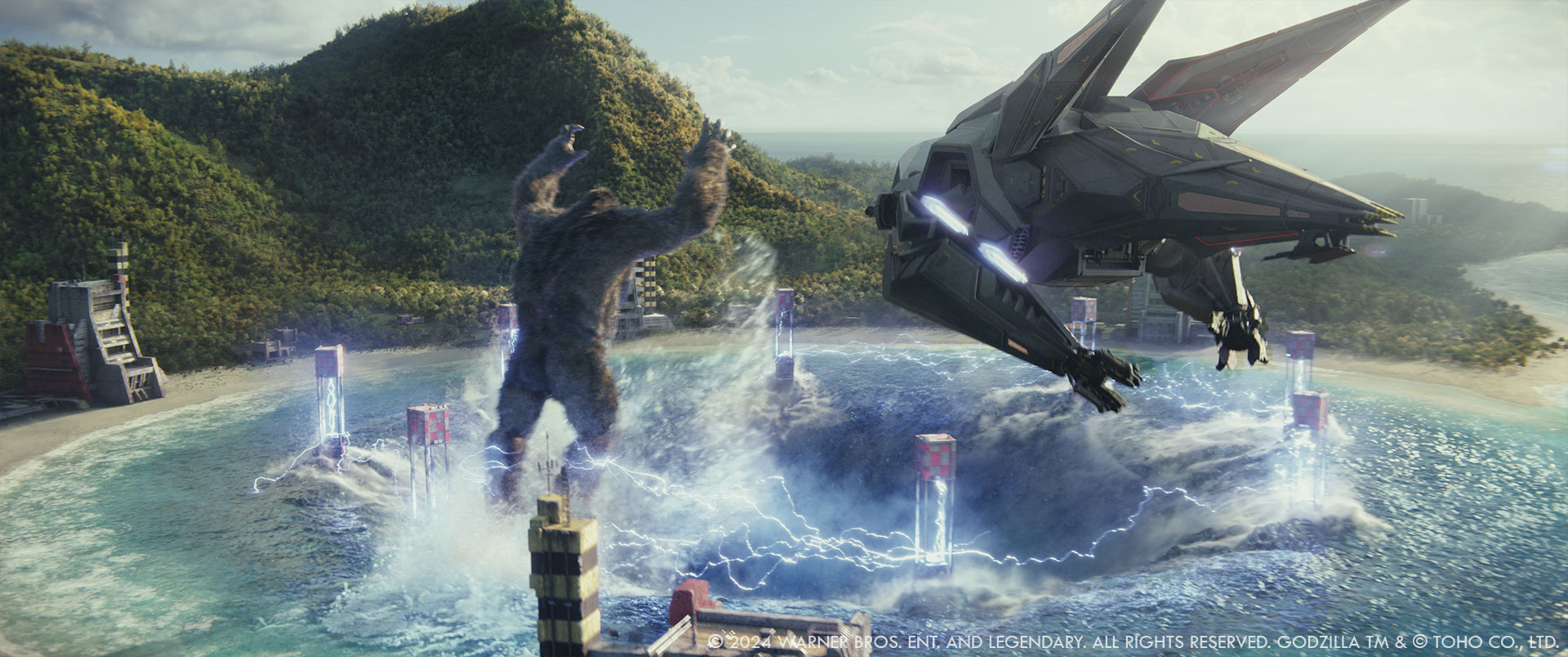
Looking back on the project, what aspects of the visual effects are you most proud of?
Aleks: Knowing what went into it, it’s hard to pick one but again the Rome fight and the Pyramid were the most satisfying.
Spencer: I’m proud that we got to contribute to the new evolved version of Godzilla, especially designing the animation for his first appearance when he bursts out of the ice.
Which sequence or shot was the most challenging?
Aleks: Originally, I expected the tooth extraction sequence would be the least difficult but it ended up being quite challenging to subtly animate Kong in a full frame.
Spencer: The most challenging by far was Kong’s tooth extraction. It took time to find the right balance of motion, it couldn’t be too much or too little. Plus, extreme close ups and subtle acting can be very subjective, and always making sure he looks like the same Kong from the Weta FX and Scanline VFX sequences.
Lee: Godzilla emerging from the iceberg is a classic fullscreen Titan destruction shot, with multiple layers of ice and snow cascading off him and bouncing off each other. Each iteration took a really long time to simulate, visualize out of FX, render out all the lighting layers, and then massage this massive avalanche in comp so that we could still see Godzilla’s performance through it all.
Is there anything specific that gave you some really short nights?
Aleks: The Kong shots due to the nature of subtle animation with particular story points.
Lee: Any late tweaks to Kong animation, requiring another round trip through muscle, skin, fur and trees or water simulation.
What is your favourite shot or sequence?
Aleks: The Rome fight sequence between Godzilla and Charybdis.
Spencer: The Rome sequences and the first reveal of “Godzilla Evolved”.
Tricky question, are you team Godzilla or King Kong?
Aleks: I was totally team Godzilla on this one. It’s not nice to choose favorites but Kong definitely gave me a much harder time than Godzilla.
Lee: I’m usually team Kong, but if I don’t get my render farm share, my Godzilla side comes out.
Spencer: Both are my favorites! I like the contrast in styles of the classic movies, but if I’m forced to pick I’d lean a bit more toward Kong simply because he was originally brought to life with stop motion.
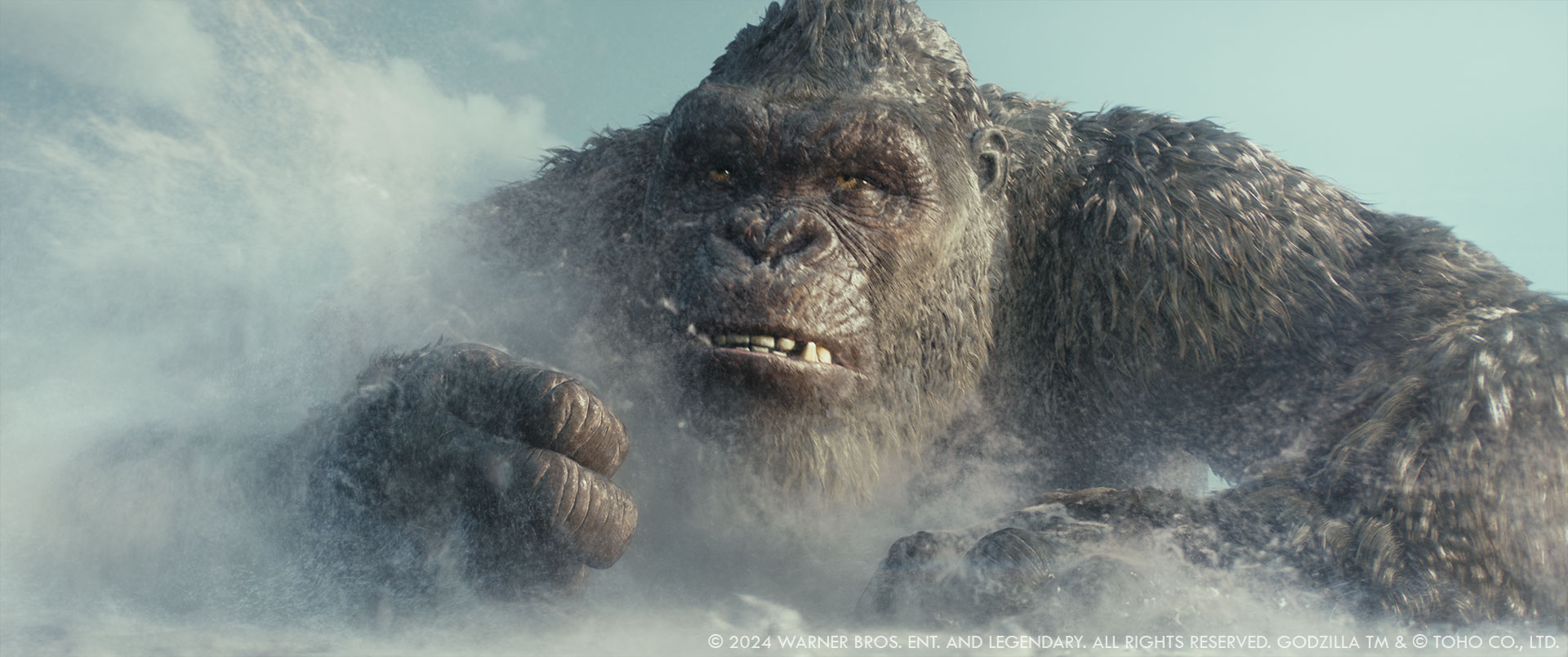
What is your best memory on this show?
Aleks: Having a chance to watch an early version of the movie back in May last year and seeing the day to day progress. Another good memory was getting Kong approved, I’m sure Alessandro would agree with me!
Lee: I really enjoyed the collaboration with the global team on this show, through some really challenging times in the industry. It was also great collaborating creatively with Aleks and Paul on this project.
How long have you worked on this show?
Aleks: I got involved in April last year after finishing Fast X.
Lee: I was drafted in late February 2023, originally just to pitch in for a few weeks, but once the MonsterVerse sucks you in, it’s hard to escape…
Spencer: A little less than a year I think. There was a bit of overlap with my previous project (No One Will Save You) so they kind of blend together.
What’s the VFX shot count?
Aleks: 312 shots.
What is your next project?
Aleks: I just started my holiday. A nice and slow story, relaxing.
Spencer: I’m on holiday too but I’d be happy to stay in the MonsterVerse if there’s another one.
What are the four movies that gave you the passion for cinema?
Aleks: I always find this a very difficult question and I’m sure I always give different movies but here are a few that are always on my top 20 list that inspired my passion and love for film: The 7th Voyage of Sinbad by Nathan Juran, Until the End of the World by Wim Wenders and James Cameron’s The Abyss and Terminator 2.
Lee: Raiders of the Lost Ark, Alien, Lawrence of Arabia and Brazil.
Spencer: Hard to pick just four but some of the movies that inspired me to choose this career at a young age are; the original 1933 King Kong, The 7th Voyage of Sinbad, Jason and The Argonauts, The Golden Voyage of Sinbad, The Wizard of Oz, all Godzilla movies (especially Showa era), classic directors like Hitchcock, Chaplain and Billy Wilder. The list is quite extensive!
A big thanks for your time.
WANT TO KNOW MORE?
DNEG: Dedicated page about Godzilla x Kong: The New Empire on DNEG website.
Alessandro Ongaro: Here’s my interview of Production VFX Supervisor Alessandro Ongaro.
© Vincent Frei – The Art of VFX – 2024






